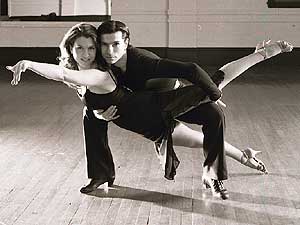|
Audio
Photos
Resources
Your Voice
|
Strictly ballroom -- no competition
April 8, 2004
Ballroom Dance. The words evoke images men and women in glitzy formal attire gliding around a room as the judges look them over. Some performers complain that under strict competition rules, there's little room or time to express themselves as artists. Now some dancers in the Twin Cities have formed a company to explore the art of ballroom dance.
Minneapolis, Minn. — Thanks to public television specials and the professional ballroom dance circuit, audiences know ballroom dance as a contest. For Deanne Michael, co-founder of Beyond Ballroom Dance Company, the competitive aspect has gotten a little too much emphasis.
"Ballroom Dance competitions are now called dance sport competitions so I think it's really, it's going more toward the sport and less toward the art form," she says.
 | |||
The seven members of Beyond Ballroom want to steer the dance back toward its artistic underpinnings. They're all ballroom dance champions of one kind or another and all except one make their living performing and teaching. They know each other primarily as dance floor adversaries. To some extent, the company's mission can be viewed as a reaction to what ballroom dance has become.
Co-founder Julie Jacobson says the cutthroat atmosphere portrayed so comically in the movie, "Strictly Ballroom," isn't that far off the mark.
"I remember being out on the floor, and having people people elbow you and put their...." She pauses. "Well, I elbowed Deanne once but that was an accident. She moved her head into my elbow."
"She gave me a black eye," Michael exclaims.
"Not my fault," Jacobson says.
Then there are the rules. There's a set time. The music is chosen for you. The five categories of ballroom dance, American Rhythm, American Smooth, International Latin, International Standard, and Theatrical or Cabaret, must be strictly followed. Each category, says dancer and judge Nathan Daniels, has its own subset of styles.
 | |||
"The International Latin category would be rumba, cha cha, samba, paso doble and jive. Those are the five dances within the International Latin category, and then on from there."
A good competitive ballroom dancer has to know them all. And, not knowing when a judge might glance in their direction, have to be "on" every second. They're constantly trying to steal the judge's gaze from each other. Company member Eric Hudson says it's like a bunch of people crammed into a room, all screaming for attention.
"The problem with a ballroom competition is there's so much going on, if you spent a whole day at a competition, your eyes and body would be exhausted from taking in all the stimulus," he says. "In our theater we're able to put that eb and flow into a context that I think it's easy and nice to watch."
Beyond Ballroom's inaugural production, on stage through the weekend at the Southern Theater in Minneapolis, is called "Interplay: Dinner for Seven."
It's a mock dinner party attended by two couples and three singles. Members say it allows them to explore some of the complexities of human relationships they only get to hint at when competing. Deanne Michael says the production gives them the time and space to take an artistic breath, and bend the rules.
 | |||
"Almost nothing that we do on this stage, could you do in competition," she says. "We have boys dancing with boys, girls dancing with girls. We've got three people dancing together. We're doing lifts all over. We're dancing by ourselves. We're just cutting loose. These are the things we dream about doing and what we love about the dance form, yet with the restrictions of competition you can't do that."
Beyond Ballroom members hope to elevate ballroom dance as a serious art form, in the same league as ballet, modern, or jazz dance. Member Theresa Kimler says don't let the industrial tans and rhinestone encrusted fashion sway your opinion.
"I like to think of what we wear as our uniform. You know the shoes, the hair, the make-up, the clothing," she says. "It's a different type of uniform than maybe other types of dance, and it looks different, but to be good at it takes just as much training and energy and commitment and years and you see a certain amount of maturity as people have more time in that form of dance just like any other form of dance."
This is Beyond Ballroom's first season. Next year, members hope to return to the Southern and take their brand of ballroom dance on a statewide tour.
|
News Headlines
|
Related Subjects
|

